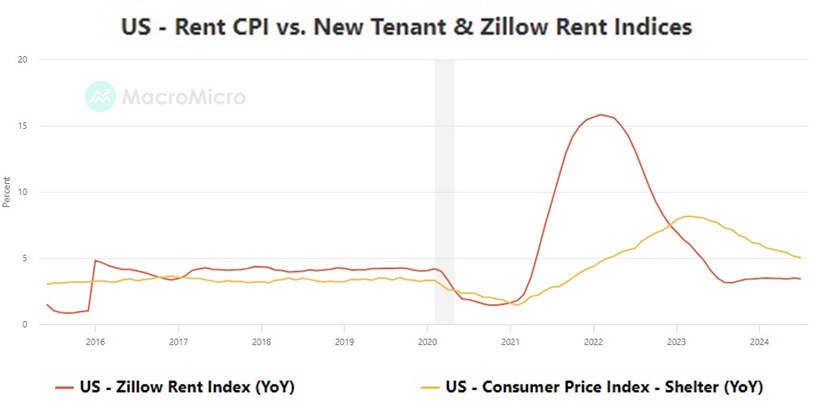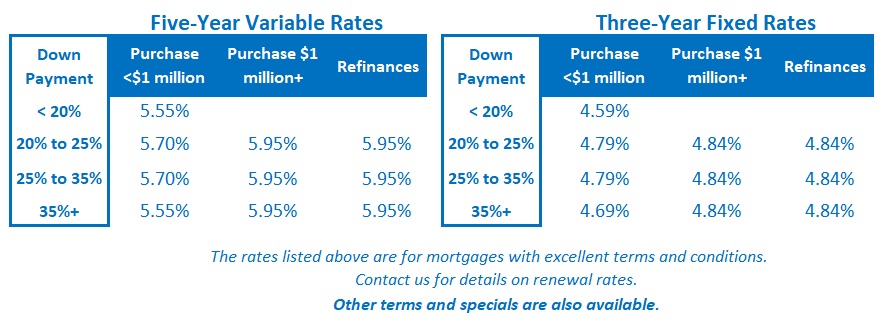Why the Canadian Employment Narrative Is About to Change
August 12, 2024Canadian Inflation Falls and the US Fed Pivots
August 26, 2024
The latest US economic data have US bond-market investors paring back their bets on a 0.50% rate cut by the US Federal Reserve at its next meeting on September 18.
Last Wednesday, we learned that the US Consumer Price Index (CPI) came in at 2.9% in July, slightly below the consensus forecast of 3.0%. The US CPI is now the lowest it has been since March 2021, and about 90% of the remaining upward pressure on prices is attributable to shelter costs.
The methodology used to calculate US shelter costs is controversial because it is slow to reflect price changes at the margin.
For example, US CPI shelter costs increased by 0.4% month-over-month in July. Most of that increase was attributed to rent costs, which are calculated using aggregated data, some of which are subjective. Over the same period, Zillow, a huge purveyor of US rental listings, confirmed that US average rents fell last month on a nationwide basis. (Hat tip to US mortgage rate analyst Barry Habib for that observation via John Mauldin’s weekly newsletter.)
In other words, US CPI is now being almost entirely propped up by the laggiest of lagging indicators. But while the US CPI shelter cost component has been sticky, real-time rental data confirm that US rents are falling, and that will ensure there is downward pressure on US CPI shelter costs going forward (see chart). If the softer-than-expected US inflation headline opened the door a little wider for the Fed to start cutting its policy rate at its September meeting, last month’s weaker-than-expected US employment data then gave the Fed all the justification it needed to walk right through it. (The Fed has a dual mandate to promote both stable inflation and maximum employment, unlike the Bank of Canada (BoC), whose mandate focuses solely on stable inflation.)
If the softer-than-expected US inflation headline opened the door a little wider for the Fed to start cutting its policy rate at its September meeting, last month’s weaker-than-expected US employment data then gave the Fed all the justification it needed to walk right through it. (The Fed has a dual mandate to promote both stable inflation and maximum employment, unlike the Bank of Canada (BoC), whose mandate focuses solely on stable inflation.)
But then, just when the coast seemed clear for the Fed to meet the bond market’s expectation with a 0.50% cut in September, the US retail sales data came in higher-than-expected last Thursday.
US consumer spending accounts for about two-thirds of total US GDP. It was estimated that US retail sales increased by 1.0% month-over-month in July, well above the consensus forecast of 0.4%. US retail sales data have been revised lower in eight of the last twelve months. If that latest number holds, it will reduce the urgency for a large near-term rate cut by the Fed and breathe new life into soft-landing forecasts.
Bond market investors took note of the strong retail data and downgraded their rate-cut bets.
The consensus is now pricing in a 0.25% Fed cut in September (down from 0.50% previously) and total cuts of 1.00% by the end of January 2025 (down from 1.25% previously).
Mortgage Selection Advice for Now
My overall assessment of our current mortgage-rate backdrop isn’t materially impacted by the recent changes in expectations around the timing and magnitude of near-term Fed rate cuts.
While the US retail sales reading was stronger than expected, I continue to believe that US consumer spending will trend lower. The US savings rate has fallen to its lowest level since the US financial crisis in 2008. It fell to 3.4% in June, well below its average long-term rate of 8.45%. At the same time, US credit-card utilization and delinquency rates have both steadily increased. The average US consumer is being increasingly stretched, and the spending data will reflect that over time.
As economic downside risks on both sides of the 49th parallel increase, so too do the odds that today’s variable rates will outperform today’s fixed-rate mortgage options.
While variable-rate borrowers must accept a higher initial rate, their rates will fall in lockstep with each BoC rate cut. Fixed-rate borrowers will have to wait until the end of their terms for any rate reduction. In a falling rate environment, the faster your rate resets, the sooner you benefit, and I still don’t think the BoC will stop cutting rates until it reduces its policy rate to at least 3%.
That said, while the case for variable rates is compelling, there are myriad factors that determine the direction of mortgage rates, and as we saw with the reaction to the latest US retail sales data, things don’t always work out as expected.
If you prefer the stability of a fixed interest rate, I think you are well advised to consider shorter fixed-rate terms today. While five-year fixed rates are the lowest on offer, I worry that five years is too long to lock in when rates are still near their recent peak.
If you are leaning towards a fixed rate, you should also pay extra attention to the terms and conditions in your mortgage contract. They vary widely among lenders and can have a surprising impact on the overall cost of your loan, especially if rates drop significantly during your term.
If you want to learn more about this topic, my post entitled What’s in the Fine Print is a good place to start. It provides a detailed summary of the terms and conditions to watch out for and links to other posts that dive deeper into the most important ones. The Bottom Line: Government of Canada bond yields were range bound again last week.
The Bottom Line: Government of Canada bond yields were range bound again last week.
Laggard lenders continued to reduce their fixed rates to adjust to the steady drop in bond yields earlier this month.
Variable-rate discounts have narrowed a little of late. I continue to expect the BoC to cut its policy rate by 0.25% at each of its three remaining meetings in 2024.







